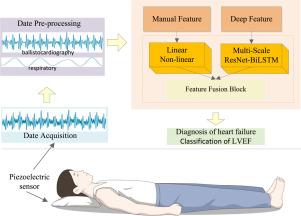Heart failure diagnosis and ejection fraction classification via feature fusion model using non-contact vital sign signals
IF 4.8
2区 医学
Q1 COMPUTER SCIENCE, INTERDISCIPLINARY APPLICATIONS
引用次数: 0
Abstract
Background and objectives:
Ballistocardiography (BCG) has emerged as a promising modality for home-based heart failure (HF) monitoring, yet existing single-dimensional manual feature analyses fail to adequately characterize left ventricular ejection fraction (LVEF 40%) dynamics. We address this limitation by developing a hybrid feature fusion framework that synergizes manual feature engineering with deep learning for improved HF diagnosis and LVEF classification.
Methods:
83 participants were recruited from a hospital, with their samples categorized into two (healthy and HF) and three classes (healthy, LVEF 40% HF, and LVEF 40% HF) based on clinical diagnosis. Non-contact vital signs were collected from supine participants using a piezoelectric sensor, and the BCG and respiratory signals were isolated using filters. We developed a model that integrates manual with deep features extracted from BCG and respiratory signals, to enhance the accuracy of HF diagnosis and LVEF classification. Additionally, we designed a multi-scale ResNet-BiLSTM network model to extract deep features from the signals, effectively capturing dynamic changes and intrinsic patterns across various time scales.
Results:
Ablation experiments show that the proposed method outperforms traditional manual methods, achieving classification accuracies of 98.20% and 98.76% for two and three-class HF classification under five-fold cross-validation, respectively.
Conclusions:
This study establishes a healthcare-oriented framework for at-home diagnosis of HF and LVEF classification, facilitating rapid preliminary screening and auxiliary diagnosis in non-clinical settings.

基于非接触生命体征信号特征融合模型的心力衰竭诊断与射血分数分类
背景和目的:弹道心动图(BCG)已成为家庭心衰(HF)监测的一种有前景的方式,但现有的单维手动特征分析未能充分表征左室射血分数(LVEF < 40%)动态。我们通过开发一种混合特征融合框架来解决这一限制,该框架将人工特征工程与深度学习相结合,以改进HF诊断和LVEF分类。方法:从某医院招募83名参与者,根据临床诊断分为2类(健康和HF)和3类(健康、LVEF≥40% HF和LVEF <; 40% HF)。使用压电传感器收集仰卧位受试者的非接触生命体征,并使用滤波器分离卡介苗和呼吸信号。为了提高心衰诊断和LVEF分类的准确性,我们开发了一种结合BCG和呼吸信号提取的人工特征和深度特征的模型。此外,我们设计了一个多尺度ResNet-BiLSTM网络模型,从信号中提取深层特征,有效地捕获了不同时间尺度的动态变化和内在模式。结果:烧蚀实验表明,该方法优于传统的人工方法,在5次交叉验证下,二级和三级HF分类准确率分别达到98.20%和98.76%。结论:本研究建立了一个以医疗保健为导向的HF和LVEF分类家庭诊断框架,促进了非临床环境下的快速初步筛查和辅助诊断。
本文章由计算机程序翻译,如有差异,请以英文原文为准。
求助全文
约1分钟内获得全文
求助全文
来源期刊

Computer methods and programs in biomedicine
工程技术-工程:生物医学
CiteScore
12.30
自引率
6.60%
发文量
601
审稿时长
135 days
期刊介绍:
To encourage the development of formal computing methods, and their application in biomedical research and medical practice, by illustration of fundamental principles in biomedical informatics research; to stimulate basic research into application software design; to report the state of research of biomedical information processing projects; to report new computer methodologies applied in biomedical areas; the eventual distribution of demonstrable software to avoid duplication of effort; to provide a forum for discussion and improvement of existing software; to optimize contact between national organizations and regional user groups by promoting an international exchange of information on formal methods, standards and software in biomedicine.
Computer Methods and Programs in Biomedicine covers computing methodology and software systems derived from computing science for implementation in all aspects of biomedical research and medical practice. It is designed to serve: biochemists; biologists; geneticists; immunologists; neuroscientists; pharmacologists; toxicologists; clinicians; epidemiologists; psychiatrists; psychologists; cardiologists; chemists; (radio)physicists; computer scientists; programmers and systems analysts; biomedical, clinical, electrical and other engineers; teachers of medical informatics and users of educational software.
 求助内容:
求助内容: 应助结果提醒方式:
应助结果提醒方式:


